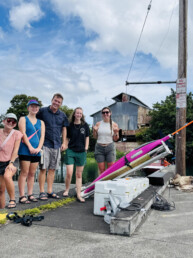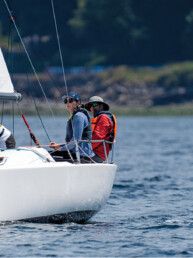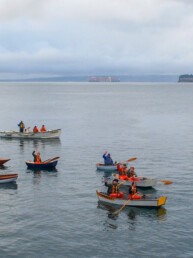The Challenges and Rewards of a Floating Office
From the August 2020 issue of 48° North.
We had successfully transited a series of rapids in British Columbia’s Cordero Strait en route to Southeast Alaska two summers ago when we faced an even bigger and more stressful challenge—finding an internet signal so I could join an important work meeting.
As Marty drove the boat around in circles off the north side of East Thurlow Island, trying to steer us to the area where a cell phone provider map showed there was coverage, I was down below, frantically trying to get my laptop connected to the meeting. We finally hit the right spot and I logged on just as the meeting started, my colleagues none the wiser about our panicked episode.
 Working aboard can be—by turns—an adventure, a headache, and one of the best perks of boat ownership. I’ve worked remotely for years, and long before the pandemic hit we’ve been figuring out how to make working from our boat possible. We’ve lived on the boat most summers over the past decade for months at a stretch, with me working aboard at the marina while Marty was at his office a few miles away in downtown Seattle. The arrangement enabled us to extend our vacation times—since Marty has more time off than me, I’d work a week or two on either end of our holidays so we could spend longer out cruising.
Working aboard can be—by turns—an adventure, a headache, and one of the best perks of boat ownership. I’ve worked remotely for years, and long before the pandemic hit we’ve been figuring out how to make working from our boat possible. We’ve lived on the boat most summers over the past decade for months at a stretch, with me working aboard at the marina while Marty was at his office a few miles away in downtown Seattle. The arrangement enabled us to extend our vacation times—since Marty has more time off than me, I’d work a week or two on either end of our holidays so we could spend longer out cruising.
Some liveaboards might already be working aboard out of necessity, with the coronavirus forcing many people to work remotely for now. But for boat owners who are lucky enough to still be employed and able to work remotely, there’s a new opportunity to turn their boats into floating offices. When Marty’s office shut down in early March, we decided to take advantage of the situation and work from the boat as much as possible. We spent most of a recent week anchored out in Eagle Harbor off Bainbridge Island, working during the day and enjoying sunsets, dinghy exploring, and walks onshore in the evenings. As I write this, we’re working from Port Townsend while finishing our re-rigging project.
Working from the boat has been mostly a fantastic experience, giving us freedom we wouldn’t have with pre-covid work arrangements. But it does require some flexibility and it’s probably not for everyone. Working in a small space is challenging. Trying to work underway, with engine noise or the boat heeled over, can be difficult, if not impossible. Some boaters might not want their work life intruding on their boating hobby. And there will invariably be times when you’d like to go sailing or sit in the cockpit enjoying a beautiful anchorage, but you have to work instead.
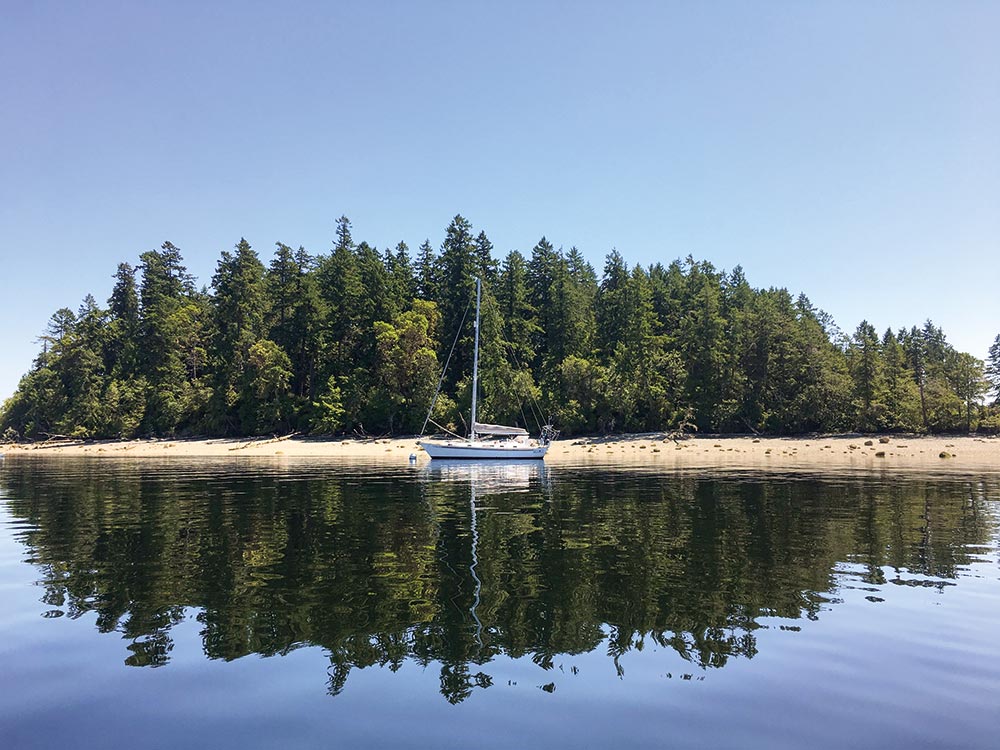 On the other hand, working aboard means that in this time of turmoil and uncertainty, the day can unfold with calming views of sky and water, reassuring evidence that while life as we knew it a few months ago is gone, some things have not changed. Starting the day with coffee in the cockpit, taking in the beauty of our surroundings, is a balm for my anxious mind. Now more than ever, our floating home feels like a sanctuary from the crises roiling the country and world.
On the other hand, working aboard means that in this time of turmoil and uncertainty, the day can unfold with calming views of sky and water, reassuring evidence that while life as we knew it a few months ago is gone, some things have not changed. Starting the day with coffee in the cockpit, taking in the beauty of our surroundings, is a balm for my anxious mind. Now more than ever, our floating home feels like a sanctuary from the crises roiling the country and world.
If this pandemic had happened a decade or two ago, working aboard might not have been possible. But access to high-speed data is more prevalent than ever, and the advent of cloud computing and new technologies like Teams and Zoom, two popular video conference platforms, are enabling people to connect and collaborate in new ways. Still, the biggest challenge by far for us working aboard has been connectivity—specifically, having an internet signal strong enough for us to do what we need to. Marty has spent a tremendous amount of time and effort thinking through our data and WiFi systems (see below for more details).
Space is another challenge and leads to some comical and inconvenient situations. If Marty is on a video call in the cockpit and I also have a meeting, I’ll go into our cabin, shut the door and do my meeting sitting on our v-berth. Our water pump makes an ungodly noise (which reminds me—we need to get a new one), so we’ll try to avoid running the water if the other person is on a call. Ditto using the head. Occasionally a boat or plane roars by in the middle of a conversation.
If you haven’t worked aboard and are considering it, you might want to give it a try at the dock first and if that’s successful, try a short cruise. Doing a proper shakedown for working aboard is as important as doing it for your boat at the start of the season. You’ll be surprised by how many little things can cause hiccups in maintaining a good boat office. For us, that largely meant making sure we had ways to charge our computers, including the right cables, headphones and adapters, and enough DC outlets.
You can also experiment in finding the best places to do your work. The navigation station often does double duty as a work desk. Same for our table in the main cabin. And is there a better office view than sitting on the pilot seat or in the cockpit and enjoying a spectacular anchorage?
If you’re thinking about working aboard, now’s the chance to make that happen. You might love it—or not. It can be fun and rewarding, and a great new way to use your boat. If nothing else, it’s adventurous and will provide some conversational fodder for those endless Zoom meetings we’re all having these days. (“That sound? Oh, it’s just a great blue heron squawking as it took off from dock.”)
Onboard Connectivity – The Holy Grail
Obviously for those who are considering working onboard, perhaps the biggest challenge is to get a secure, high-speed internet connection. We’ve been wrestling with this issue for years, spending probably a bit too much on gear and equipment that at the end of the day often failed to produce the results we wanted.
On the other hand, as the years have progressed, so has the availability of high-speed cellular data across most of the Salish Sea. That alone has made working from a boat much less of a headache.
When we first started down this path, a simple WiFi extender was usually enough to pick up a free WiFi signal from some unsuspecting homeowner in the area. But these days, almost no one has an unsecured WiFi signal. Plus, if you ever tried to pick up a Wifi signal at a marina, you’re probably familiar with how frustrating and difficult that can be.
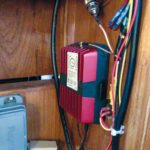
In the latest update to our internet systems aboard our Passport 40 sailboat, Meridian, we decided to focus on cellular data. We purchased an LTE modem to pull in cellular data and then connected that modem to a WiFi router so our laptops and iPads use that cellular signal. To make the system work better in locations without a strong data signal, we installed a cellular signal booster with an external antenna. This boosts all cellular signals, so it helps the modem to provide high-speed data, but it can also improve phone call quality too, provided you keep the phone near the booster antenna.
For anyone who really wants to get into the technical details, we highly recommend visiting local boater Steve Mitchell’s website at SeaBits.com and reading his columns in 48° North. He has an amazing collection of technical posts around his various efforts of installing and testing high-quality components to stay connected onboard.
We’d love to hear about your experiences working onboard — what challenges you’ve encountered and how you addressed them, unresolved issues, highlights, misadventures and anything else you want to share. Drop us a line at editor@48north.com.


